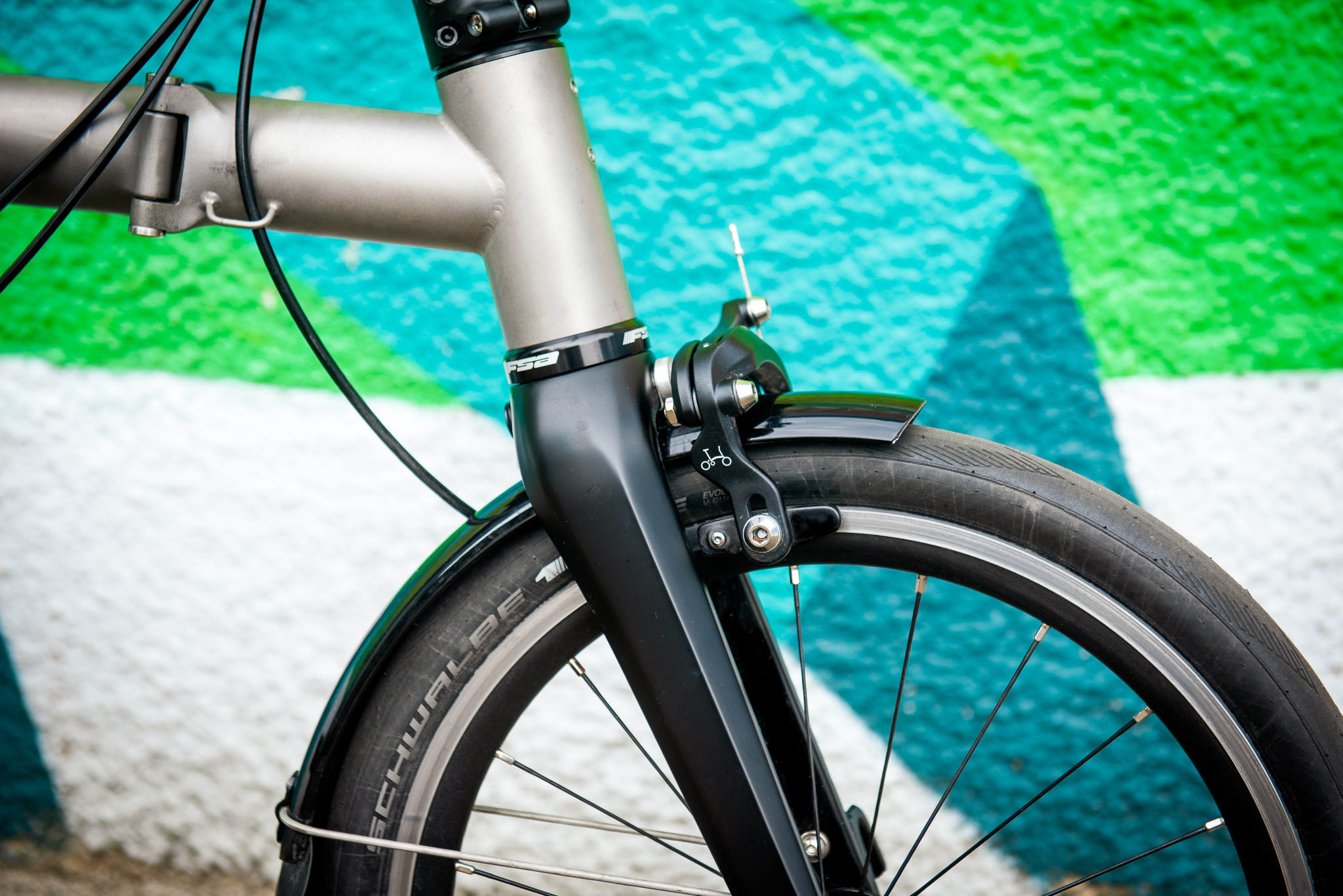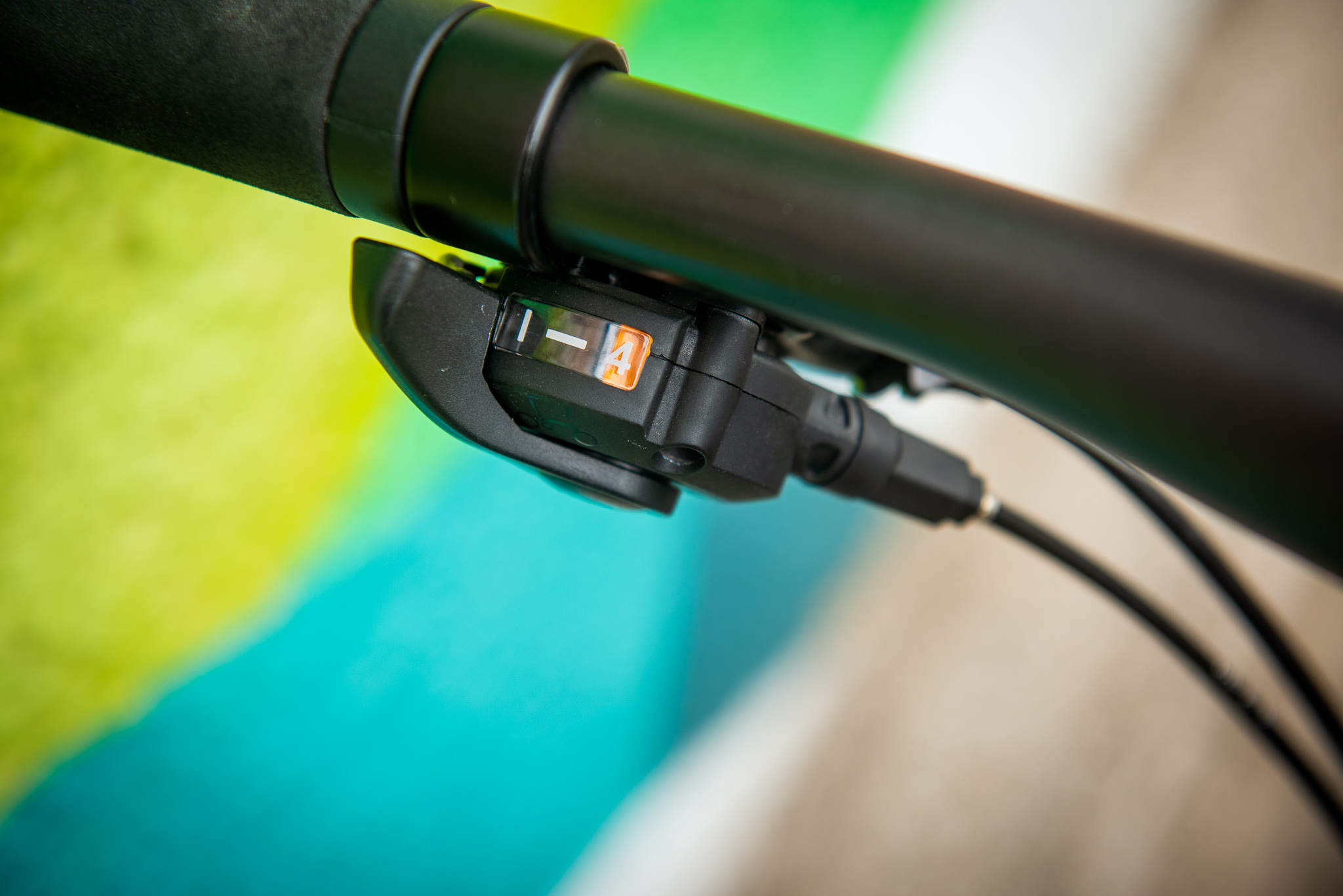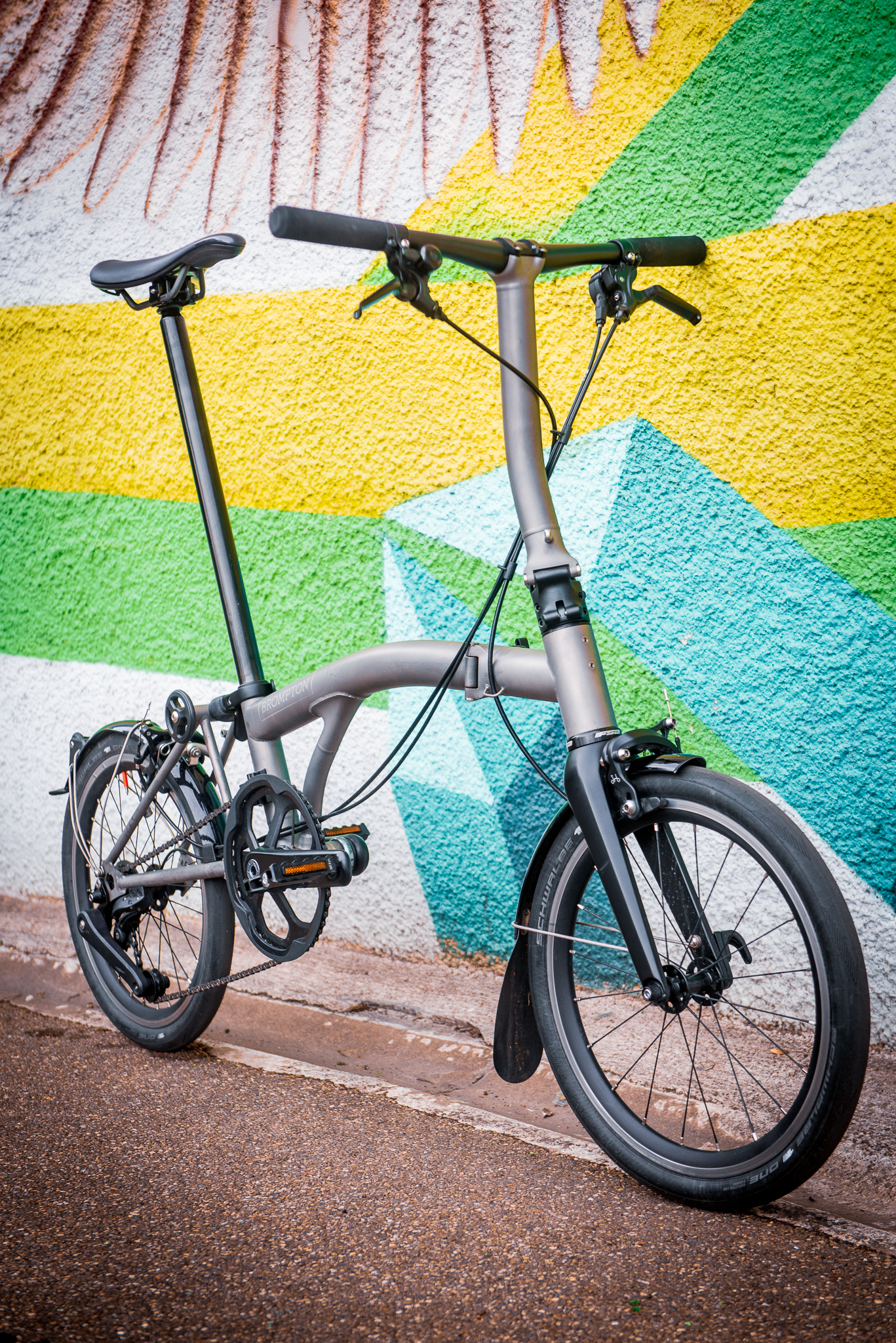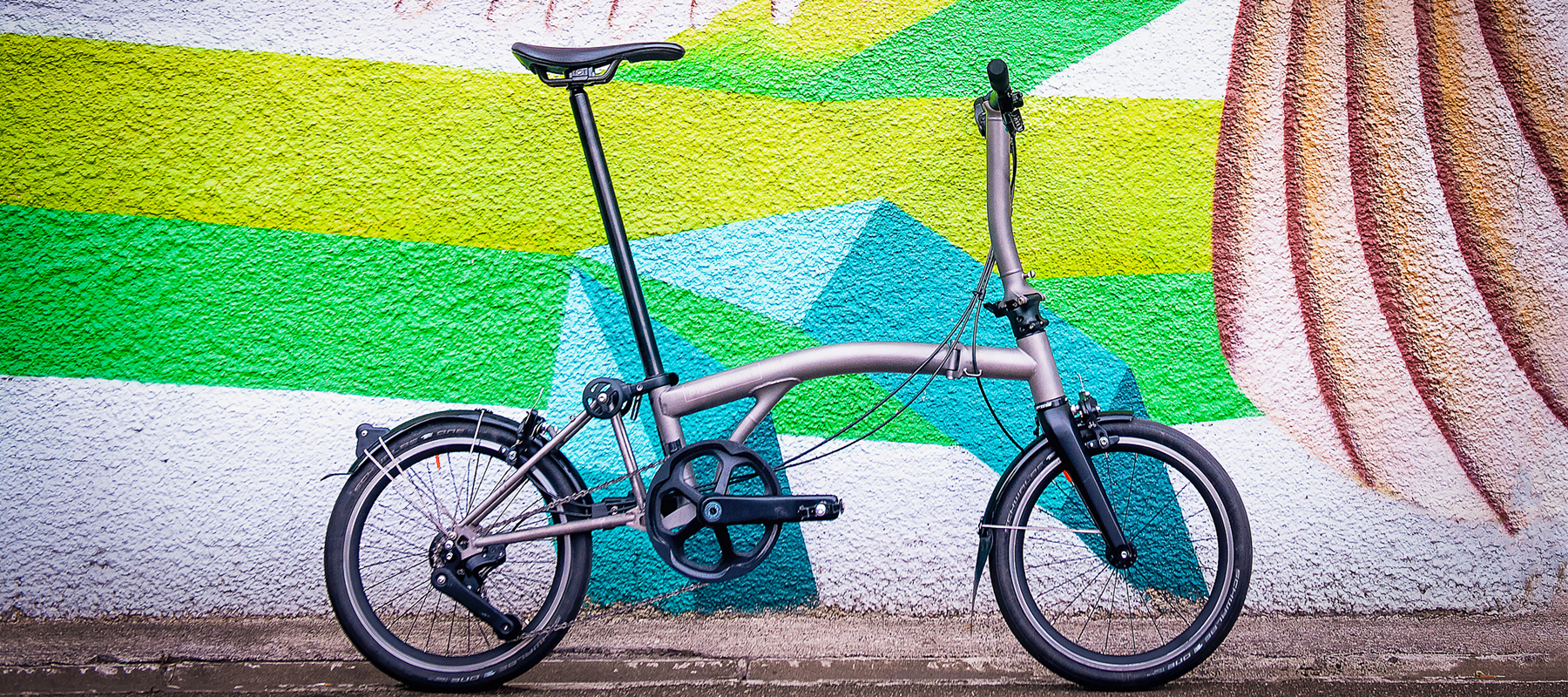Cyclingnews Verdict
The T-Line represents a batch of innovations, and outperforms its steel counterpart in every area
Pros
- +
Super light weight
- +
Fantastic ride quality
- +
Innovative fold
- +
Multiple new components and features
- +
Durable and strong
- +
Stunning design
Cons
- -
An expensive price point for commuting
You can trust Cyclingnews
Brompton is a unique brand in cycling. On one hand it appeals to utility cyclists on the most functional level, on the other it boasts a unique urban chic that’s led to collaborations with cyclists like David Millar and upmarket brands like Barbour. Brompton's brand new flagship titanium T-Line goes even further on both fronts, as it may well be the most functional and stylish bike Brompton has ever made.
The proposition of the Brompton T-Line is a simple one. This is the lightest Brompton ever, and the most expensive.
In its lightest single speed form, the bike weighs only 7.45kg, while our Urban model with four gears comes in at a mildly heftier 7.95kgs (complete with mudguard, pedals and roller wheels). To put that in perspective, an entry-level Brompton B75 weighs 11.6kgs, and is not even the heaviest in the range.
Compare the T-Line to the world of premium road or gravel: where the thought of cutting 4kg off a frame would be enough to have weight weenies brawling in independent bike shops.
Historically, it’s not been unusual to see the very lightest WorldTour bikes easily top the £10,000 mark, and with that in mind, the Brompton’s T-line's £4,180 price tag may not seem so galling. After all, this is a folding titanium bike that not only slices 4kg from the conventional steel bike but weighs less than many of its fully-sized titanium road bike cousins.
But with such a big release, and such a large cost, the key question is whether the Brompton T-Line represents a lightweight gimmick or a true substantial step forward in performance. After nearly six months on the Brompton T-Line, and hundreds of miles, I feel fairly certain of the answer.

Design and aesthetics - handmade titanium
Titanium is an acquired taste when it comes to bikes. The intense light-sapping greyness of titanium doesn’t jump out to the average onlooker. In my years of testing the highest-end bikes, I've rarely had a compliment on a titanium bike from anyone but the most seasoned bike fans.
Take a glance at its muted tones from a distance, and it would be easy to overlook the underlying craft of a Grade Nine titanium frame hand-built and assembled in the UK. Up close, it's a carefully crafted bike and a striking piece of manufacturing, and I admire the T-Line for that subtle aesthetic. Even more striking is that virtually every component of the bike has been built by Brompton, in the UK.
Despite what seems like a thoroughly controlled design, Brompton has stepped into this first run of the new bike category with caution. “We know that we could sell more bikes, but we're launching a limited number of bikes,” said Brompton’s head of product management, Joel Natale, to Cyclingnews. “Making one of anything is a doddle, making 1,000 exactly the same way is when it gets hard.”

Yet that first generation reticence seems so misplaced. Drawing on Brompton’s engineering and manufacturing experience, the T-Line just seems so complete. This isn’t a V1, a V2 or even a V10 of this class of bike - instead the maturity of its design reflects generation after generation of incremental improvements.
With so much new on the T-Line, we may have expected some minor oversight, a niggle here or there, but I struggled to find any part of the bike that wasn’t well-considered. From the titanium cable guides to the neatly welded tubes, the integrated front pannier mount to the precisely moulded aluminium hinge clamp plates, the T-Line seems so honed.
That attention to detail is most evident with the fold itself, where every component snaps into another with seemingly airtight accuracy. Stare long enough at any individual part of the T-Line and a secondary folded purpose will soon become evident - whether it be a saddle with a hand grip beneath the nose or a mudguard with a roller wheel mounted above it.

Of course, foldable practicality isn’t where this bike excels in relation to other Brompton bikes – all of which boast the brand’s unique fold. Instead, it’s every other element of the T-Line’s performance and practicality where it stands out.
Aside from titanium rendering the frame a little hard to clean and prone to marks, on a practical level, it outperforms steel in every sense on a Brompton. First and foremost, that’s because of the weight.






Performance - Cutting weight, gaining comfort
Our Brompton T-Line comes in at 7.95kgs, but that includes both mudguards, roller wheels and pedals. Remove the 300g mudguards and you could get it down to 7.6kgs with pedals - a weight that few titanium road bikes could rival.
Riding with an extra 3kg of mass is noticeable to many, but carrying a 12kg folding bike up stairs is something no flat-dwelling commuter easily forgets. By bringing the weight down to 7.95kgs - Brompton has really transformed the ease of handling the T-Line on a practical level. That’s a huge gain when rushing into a crowded train or squeezing into a busy pub after work. While Brompton’s e-bike offering may make pedalling easier, this makes everything besides far less strenuous, and that shouldn’t be overlooked.
While practicality stands out when off the bike, the impact on the ride quality from the low weight and titanium tubing is what has made its biggest impression on me.
Given titanium's reputation in bike building, we might expect the Brompton T-Line to be softer and more flexible at a lower weight, but that wasn’t my experience.
Product manager Joel Natale explained that in terms of stiffness, the bike maintains what the steel does in performance terms, “It maintains the stiffness from bike to bike, it just about sneaks into more compliance, but has comparable actual stiffness.”
To maintain stiffness, Brompton has opted for wider tube shapes, which has led to wider effects on ride quality.
“From the handlebar to the cranks, you'll notice a little bit more stiffness - and from the cranks in terms of drive,” Natale explained. “But the long titanium stem is going to have some flex in it, like it's kind of in the nature of the design in the materials.”
To me, there is a really noticeable responsiveness at the rear end - where a wide platform and lighter overall weight lead to a more efficient transfer of power. Aided by its small diameter wheels and brand new lightweight and supple Schwalbe One Brompton tyres, the T-Line just takes off.

While this is certainly no road bike in speed terms, the T-Line was easily quicker than my pannier-laden commuter, and I found myself happily cruising through city streets above 30km/h.
At the same time, the T-Line manages to eke out more comfort and - more importantly - control as a result of the titanium. Compared to a classic steel Brompton, the titanium frame bounces less over bumps, and generally offers the rider more control.
Beyond that, the T-Line enjoys that gentle rumble that is so distinct to titanium dream bikes like a Passoni or Moots - feeding the contours of the road through the pedals and handlebar without allowing them to disturb the rider.
That’s one reason why I was more than happy to ride the T-Line for long stretches, and clocked several 30-40km rides on the T-Line.
The brand new carbon-steel seatpost, accompanied by a new but more widely used elastomer, plays a big part in that smoother ride quality too.
“This is the literal opposite of what we see in early carbon road bikes, which applied carbon external layers to a seatpost,” said Natale, of the new T-Line Superlight seatpost. “You have a carbon tube on the inside and you have 0.3mm of steel sitting on the outside of it, just to protect against scoring of the carbon, because of the repeated movement of the post.”
Sure enough, despite lifting and lowering the seatpost on every ride for months, there isn't a mark on it.
This brings us to the wider picture of the T-Line, and the complement of updates that go beyond the titanium frame.

The wider picture
You'd be forgiven for overlooking that the T-Line is Brompton’s first foray into carbon forks, and an A-headset in place of the conventional quill stem. Beyond that, we see a new tyre - the aforementioned Schwalbe One - a new carbon handlebar, a brand new carbon seatpost and an almost completely re-conceived bike.
Amongst its host of new features, the T-Line showcases brand new pedals for Brompton. While the folding pedals are now part of the Brompton aesthetic, these CNC aluminium pedals offer a far more rigid and lighter interface.
The quick release pedal bayonet is the crowning gadget here, though, meaning you can squeeze the quick release at the crank to release the pedal, then pop it into a magnetic holder behind the fork - smartly designed in a way that folding out with the pedal in place led to no downtube scratches - and it was always safe from knocks or jolts.
In terms of shifting, the Urban's four-speed groupset sports a 50T chainring and 11, 13, 15 and 18-tooth cassette sprockets. I am definitely an advocate of including this shifting system at the cost of 500g, as it hugely widened the versatility of the T-Line.
The range is fairly well suited to urban riding, and I certainly had to face a few drags of several kilometres at 5% when riding it. While I didn’t struggle in terms of range, in nasty weather the gears can skip when loaded under high pressure. However, I consider this a lightweight micro-groupset rather than a performance-shifting system, and in that sense, it does the job more than adequately.
I could discuss the wider component choice at length - from the Tubolito TPU inner tubes to the carbon bar and foam grips - but the overall takeaway was that after six months of riding, each of these offered its own unique charm and will offer excellent trickle down upgrades to Brompton's steel models in seasons to come.











Ahead of the competition
The Brompton T-Line is not the only ultra-light, or ultra-luxury, folding bike on the market. I would argue, however, that it is the best.
Hummingbird’s folding bike, for instance, hits an even lighter weight point than the T-Line at 6.9kgs and costs £3,495. There is a trade-off, though, in that there are no frills in terms of mudguards or pannier mounts. From personal experience of riding it, the small carbon frame is also markedly stiffer, but at the expense of handling and ride quality. This is not a bike that sweeps over the road like the T-Line.
The carbon frame also doesn’t fold itself, meaning the finished folded form is fairly large. That said, nothing folds quite like a Brompton.
Compare the T-Line, for instance, to the GoCycle G4 - a smart compact electric commuter. While the GoCycle isn’t marketed for its foldability, it's striking how much more space it takes up while folded.

We might wonder why Brompton didn’t opt for carbon fibre, as both the GoCycle and Hummingbird bikes have. While carbon may have saved weight, given the aggressive folding action of a Brompton, and its tight tube junctions, Brompton's designers felt titanium was a far safer option - and that seems to ring true.
After carrying it and riding it over many months, and even falling off it, I was left with the sense that this bike was as robust as they come.

Verdict
The Brompton T-Line is the polar opposite of an affordable commuter bike, and so onlookers are welcome to gawp at the enormous price tag. Yet if Brompton wanted to purely create an expensive range-topper, they could have charged a lot more and tried far less. For £4,180 , this is a lot of bike - albeit in a very small package.
The hand-built titanium frame may take centre stage, but the T-Line is actually a collection of innovations and new releases for Brompton, all of which have proven the test of time during our long-term test.
This is such a finely honed machine that I’m splitting hairs to even imagine ways it could realistically be improved. Only the shifting system leaves anything to be desired, and even there I wouldn't sacrifice the low weight for better shifting.
I never imagined needing or wanting a Brompton, yet as our test ends I’m struggling to imagine my life without the ease of an ultra-lightweight bike that can fit beneath my desk and behind my sofa.
There is absolutely no mystery as to why the T-Line has boasted a lengthy waiting list from the moment it was released – this is simply a wonderful piece of bike design.
The Brompton T-Line is available directly from Brompton. Frequently sold out, and released in regular, small-volume drops, sign up on Brompton's website to receive information on the next release.
| Attributes | Notes | Rating |
|---|---|---|
| Design and aesthetics | Iconic, and the gold standard for folding bikes. Let down by limited colour range. | 10/10 |
| Components | Aside from shifting, the components are exceptional all around | 9/10 |
| Performance, handling and geometry | For commuting, using public transport and diving down cycle paths it's unmatched | 10/10 |
| Weight | Simply game-changing | 10/10 |
| Value for money | Expensive, yes, but a lot of value for what is on offer | 9/10 |
| Overall rating | Row 5 - Cell 1 | 96% |

Peter Stuart has been the editor of Cyclingnews since March 2022, overseeing editorial output across all of Cyclingnews' digital touchpoints.
Before joining Cyclingnews, Peter was the digital editor of Rouleur magazine. Starting life as a freelance feature writer, with bylines in The Times and The Telegraph, he first entered cycling journalism in 2012, joining Cyclist magazine as staff writer. Peter has a background as an international rower, representing Great Britain at Under-23 level and at the Junior Rowing World Championships.
